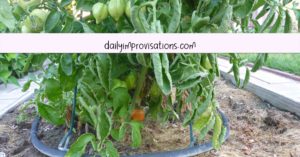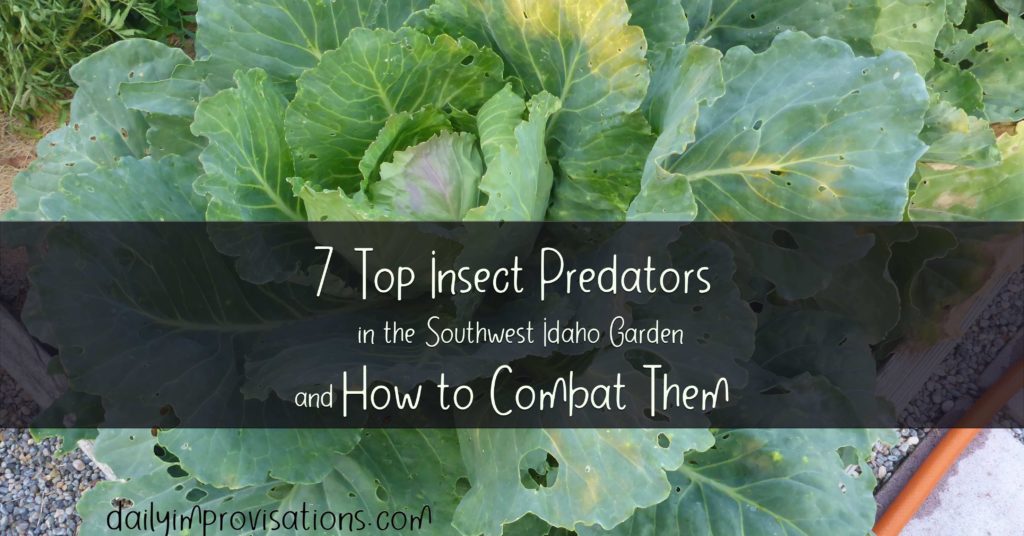How to identify insect trouble
The heat of summer seems to be prime time for insect populations to invade the garden. They can do devastating damage quickly, so it is a good idea to know not only what to look for, but what can be done to save your crops. My most consistently troublesome insects are:
- Aphids
- Earwigs
- Grasshoppers
- Cabbage worms, which are cabbage moth caterpillars
- Cabbage maggots
- Pill bugs
- Squash bugs
These are not the only insects I have had trouble with, but they are the ones I have to deal with every year.
Once a plant looks obviously stressed, it can be too late to help it. It is best to keep an eye out for both beginning signs of insect damage and the actual presence of insects. Let’s review the basic things to look for with each insect.
Aphids – curling leaves, leaf discoloration, aphid populations on the undersides of leaves, oddly colored broccoli heads, broccoli heads that look sparse and thin; most of the aphids I see are gray and the size of a pin head, but I did have some larger green triangular ones on a pumpkin plant one year.
Earwigs – inner and base of leafy plants are eaten, slimy areas on the foliage near the base of the plants, presence of earwigs, foliage or fruit eaten
Grasshoppers – large portions of plants missing, grasshoppers present in the yard
Cabbage worms – big holes in leaves, white cabbage moths flying around laying eggs, bright green worm-like caterpillars in various stages of growth
Cabbage maggots – thinning of the plant near the base where the stem connects to the roots, a gradual change in plant color from green to grey to purplish, stunted and dying plants, the presence of ants (See my more complete article on cabbage maggots here).
Pill bugs – holes eaten in the fruit of the plant
Squash bugs – squash plant starts to look limp and brown, squash fruit is stunted and discolored, small dark golden eggs in batches under the leaves, brown adult and grey juvenile squash bugs on stems near the center base of the plant. (click on any photo to enlarge)

Basic ways to minimize trouble from insects
Different insects have their favorite plants, but there are some common things that can be done to keep any plant less prone to insect damage, so I’ll start with that.
- Water appropriately. This is for two reasons. One, a properly watered plant is healthier and can tolerate a bit of insect invasion better. Another reason is that an overly damp environment is inviting habitat to many insects. (If you would like some ideas on organizing your watering, click here.)
- Don’t overcrowd your plants. When plants are too close together, it makes it harder to both spot and treat insect pests.
- Keep produce dry and off of the ground. This can be a multi-pronged approach including ground only watering, trellising, and/or a dry mulch of hay or grass on the ground around the base of the plants.
In fact, these are the main things I do to deal with pill bugs and earwigs. I have never specifically targeted either of these insects for extermination.

Safe ways to get rid of insects
One of the nice things about these 3 methods of insect control is that they are broad-spectrum, meaning that they can be used to combat many different insect pests, not just the ones listed above. They are also basically benign. There are some cautions, some of which I will mention, but none of these methods are a significant risk for anyone other than the insect.
Handpicking:
There is nothing as safe for you, your children, or your pets as hand picking insects. It basically the only reliable way to get rid of squash bugs. Sometimes this can be aided by spraying some garlic water at the base of the plant to make them all scurry out.
Handpicking can also include disposing of whole plants, such as the first infested plants. This may be a good option for insects that are not easily individually removed, like aphids.
One of the drawbacks to handpicking is that it is time consuming. It can also be difficult to see some insects, such as cabbage worms. Some insects are so active that they are never in one place for long. Or they only spend time on the plants at night. Last, but not least, handpicking means really getting into the foliage, which can result in more than the usual number of bug/spider bites or itchy skin from contact with plant material.

Diatomaceous earth:
The riskiest thing I know of about diatomaceous earth is the same as accidentally inhaling any powdery substance. As long as you combine being up wind and sprinkling fairly close to the plants, there should be little or no risk of this. For comparison, it is recommended that a little diatomaceous earth be put in chicken feed to help kill parasites.
Diatomaceous earth works by cutting through a insects body. I have seen this work on ants when applied to an ant hill in a very inconvenient place. Water does significantly decrease the effectiveness of diatomaceous earth.
One drawback to diatomaceous earth is that it does not discriminate good insects from bad insects, so if you see a lady bug or spider, you might want to relocate them. On the other hand, I have always had an abundance of beneficial insects in my garden, and have never seen any of them laying around covered in the powder. You can probably keep from affecting bees by avoiding getting the dust on flowers.
Insecticidal soap:
This is the only method that I find truly effective against aphids. I end up needing to apply insecticidal soap to almost all of my cole crops (broccoli, cabbage, Brussel’s sprouts) once the warm weather hits.
The bottle that I have says it can burn eyes (as any soap would) and skin (it has been on mine without issue and I have hyper sensitive skin). Again, this method may also harm good insects, but it does seem that harmful insects are more susceptible to it.
Insecticidal soap usually needs to be applied every few days for at least three applications, but the good news is that produce can be eaten the same day (presumably after washing, and please read the label on your own bottle).

When you need something tougher
There are many years when these are the only methods of insect control I need for my vegetable garden. Sometimes I also add Bonide Eight Insect Control for particular small beetles on tomato or potato plants, but that usually ends up being a one time application.
I am not a purest organic gardener, but I simply refuse to use anything that could poison a child or pet. I don’t think my garden has suffered from that. In fact, most years I am giving away produce and get many compliments on how beautiful my garden is. A little diligence combined with timely intervention is better than the strongest pesticide. And in the midst of it all, always take a moment to appreciate what is going well and looking beautiful.




Leave a Reply